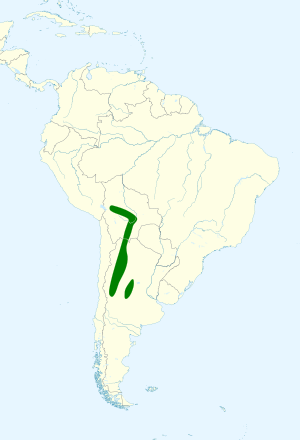Grey-hooded parakeet facts for kids
Quick facts for kids Grey-hooded parakeet |
|
|---|---|
 |
|
| At Capilla del Monte, Córdoba, Argentina | |
| Conservation status | |
| Scientific classification | |
| Genus: |
Psilopsiagon
|
| Species: |
aymara
|
 |
|
| Synonyms | |
|
Bolborhynchus aymara (d'Orbigny, 1839) |
|
The grey-hooded parakeet is a type of parrot found in parts of northwestern Argentina and Bolivia. It is also known as the Aymara parakeet or Sierra parakeet. These birds live in high-up, warm areas with lots of bushes and shrubs.
Contents
About the Grey-Hooded Parakeet
The grey-hooded parakeet is a small, slim bird. It grows to be about 20 cm (8 in) long. Its upper body is green, and its sides and underwings are greenish-yellow.
Its head is brownish-grey, and its chin, throat, and chest are whitish-grey. Sometimes, there's a hint of blue on the sides of its chest. The belly is green with a bluish tint. Its long, thin tail is green on top and grey underneath.
The parakeet has a flesh-colored beak and brown eyes. Its legs and feet are brownish-grey. Males and females look similar. However, males often have a brighter grey chest. Young birds have shorter tails.
Where They Live and Their Home
The grey-hooded parakeet lives in the southern Andean Yungas region. This area stretches from southern Bolivia to northern Argentina. They might also be found in the northern parts of Chile.
These birds prefer dry, bushy, or wooded places. They can be seen in wooded valleys and thick shrub areas near villages or farms. They live at high altitudes, from about 1,800 to 4,000 m (6,000 to 13,000 ft) above sea level.
Life and Habits of the Parakeet
Grey-hooded parakeets are social birds. They usually form small groups of about twenty birds. Several of these groups might gather together at places where they can drink water.
These flocks fly quickly and low across the countryside. Their flight path often goes up and down. They sometimes rest on top of or among the branches of bushes and small trees. While resting, they make twittering and warbling sounds. These sounds are quite similar to those made by a barn swallow.
They find their food in low plants. They eat seeds from grasses and plants like asters. They also enjoy berries and fruits. Sometimes, they search on the ground for seeds and fruits that have fallen.
Reproduction and Nests
Grey-hooded parakeets usually breed in November. They build their nests in holes they dig in earth banks. They might also use cracks in rocks or holes in cacti. Sometimes, they even nest in old, ruined buildings.
Several nests can be found close together, forming a small colony. A female parakeet typically lays four or five eggs in a clutch.
Conservation Status
The grey-hooded parakeet is a fairly common bird. It lives across a very large area. There are no known major threats to this bird's survival. Its population is thought to be stable.
Because of this, the International Union for Conservation of Nature says its conservation status is "least concern". This means they are not currently at risk of disappearing.
See also
 In Spanish: Catita serrana grande para niños
In Spanish: Catita serrana grande para niños


